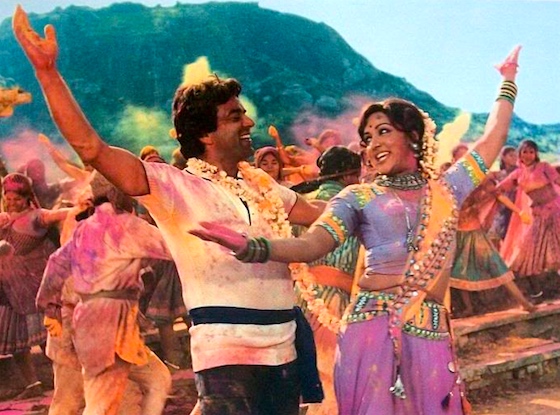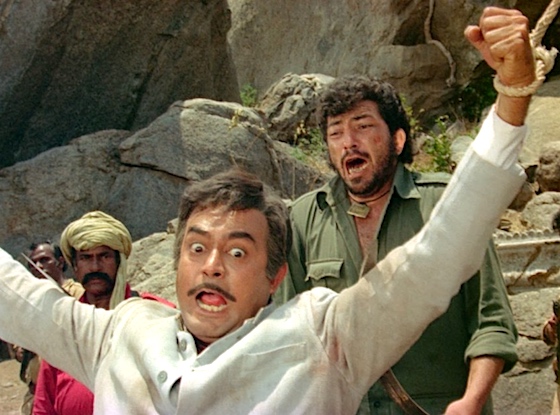Ramesh Sippy | 205 mins | DVD | 4:3 | India / Hindi | PG

For many Western readers (and the stats say most of mine are, though India is in 3rd of all countries for 2019 so far), there’s every chance you’ll’ve only heard of Sholay (if you’ve heard of it at all) as “one of those Indian films that’s on the IMDb Top 250 nowadays”. But in Indian culture it’s a much bigger deal, a huge and longstanding success; like Star Wars or something is to us, I guess, only without the reams of sequels and spinoffs and merchandise and theme parks. Instead, it’s enjoyed remarkable success of its own: it topped the Indian box office for 19 years, was the first film in India to celebrate a Silver Jubilee at over 100 cinemas, and eventually set a record of 60 Golden Jubilees across India. From a British perspective, in 2002 it topped the BFI’s “top ten Indian films of all time” poll, and in 2004 it was voted the “Greatest Indian Movie” in a Sky poll of 1 million British Indians. I first heard about it years ago in that context, and my desire to see it was only exacerbated when it made it onto IMDb’s list. All of which is why I chose it to be my second-ever #200.
It’s a tricky film to sum up, because it offers a massive mash-up of tones and genres in a way we’re not accustomed to from Western cinema. There are whole sequences (not just fleeting moments) of broad slapstick humour, epic action, heartfelt romance, brutal violence, colourful musical numbers, intense tragedy, plus backstory that’s filled in via regular, lengthy flashbacks. It wouldn’t be a stretch to say its primary genre was Action, or Comedy, or Musical, or Western — it’s all of those things, by turn; sometimes at the same time. Apparently it’s a defining example of the “masala film”. Masala is, of course, a mix of spices in Indian cuisine, and the films that take that name blend genres together, typically (according to Wikipedia) action, comedy, romance, and melodrama, plus musical numbers.

That sounds like a recipe for disaster, but what’s perhaps most remarkable about Sholay is that it pulls them off. Thanks to engaging characters and relationships, powerful and humorous performances, quality filmmaking (there’s some strikingly effective camerawork and editing in the big scenes), it all flows. You can see why it became such a success: there’s something for everyone. And you can see why it struggles to transcend the culture it originates from, because when Western movies ever even vaguely attempt this kind of range of tones, there are trolls aplenty waiting to rip them apart for the perceived fault of being tonally inconsistent.
The heroes are Veeru (Dharmendra) and Jai (Amitabh Bachchan), a pair of crooks with hearts of gold, who are recruited by a retired policeman who once arrested them, Baldev Singh (Sanjeev Kumar), to capture a wanted outlaw, Gabbar (Amjad Khan), who’s terrorising Singh’s village, and who he has a personal history with. The way that storyline plays out is highly reminiscent of Spaghetti Westerns and the samurai movies that inspired some of them — anyone who’s seen the likes of A Fistful of Dollars, Seven Samurai, or Once Upon a Time in the West (or any of the other films that have riffed on / ripped from them) is going to see a lot of reflections here. I don’t mean that to be a criticism — after all, Dollars was an unendorsed remake of Yojimbo, and Seven Samurai was remade as classic Hollywood Western The Magnificent Seven, so there’s strong pedigree among these movies for reworking each other to excellent effect.

Sholay certainly adds its own stuff to the mix. I mean, those other films I’ve mentioned don’t have musical numbers or slapstick comedy (not much of it, anyway). Lest you think this plays as a spoof, Singh eventually unveils a tragic backstory (and a neat twist to his character), and Gabbar is a properly despicable, nasty villain. Plus, like most of the best bad guys, he’s not just evil for evil’s sake — he’s motivated to subjugate this particular village for a reason — but he’s still a properly nasty piece of work, excessively and inventively cruel. Rather than a spoof, then, the different genres come into play via an array of plots and asides. At times it does feel like a selection of unconnected subplots to bulk out the running time (and, as you may’ve noticed, it does have a long running time), but most of them come together in the end. Your tolerance for those that don’t (a lengthy comedic aside in a prison, for example) is another matter.
Musical numbers are another thing that put some people off. There are only five though, and they don’t actually drive the plot that much — I was kind of forced to assess their impact, because for some reason my DVD copy didn’t bother to subtitle the songs, leading me to search out translations online so I could get the gist. Still, when they fill several minutes of screen time each, it is nice to at least have an idea what’s being said sung!
In the West, Sholay has been hard to find at times (personally, it was years ago that I managed to source an out-of-print DVD by a label you’ve never heard of from an Amazon Marketplace seller), but as of this week it’s available on Amazon Prime Video in the UK (either as part of a subscription or to rent and buy individually), and in HD to boot! Based on the running time it’s the shorter widescreen theatrical version; there’s also a longer, open matte 4:3 “director’s cut”, which is what I watched. There’s info on the differences between the two cuts here, but the mostly it’s a couple of bits of violence that were censored. The biggest change, though, is the ending. No spoilers, but I think the original version is better — it included one of my favourite parts of the entire film, in fact. The revised version was at the insistence of India’s censor board, and includes a heavy-handed moral lecture — it’s not just less good in itself, it also feels overtly censor-mandated. Oh well.

On the bright side, the 4:3 version isn’t great to watch compositionally. The makers wanted to produce an epic 70mm widescreen kinda movie, but didn’t have the tech to do it properly, so they shot it in full frame 4:3 on 35mm and then had it cropped and blown up in London. Watching in 4:3, it’s obvious that it was always intended to be cropped to widescreen: there’s loads of dead space above everyone’s heads, things like that. That said, every once in a while there’s a shot that seems to be perfectly framed. Maybe they look just as nice cropped, I don’t know. To further muddy the waters about different versions, five years ago Sholay was converted to 3D. Despite the film’s enduring popularity, it didn’t come close to making its money back (the conversion cost US$3.5 million, but the 3D release only grossed US$1.4 million). In the West the studio would seek to recoup more of that with home media, but apparently Blu-ray isn’t popular or successful in India, so the chance of getting a 3D BD is basically nonexistent. But, as I said, it’s on Amazon in HD now, so at least there’s that. (Hopefully it has subtitles for the songs…)
Whichever version you watch, Sholay is best described as “an experience”. Perhaps lots of Bollywood movies are like this (after all, with huge success comes huge influence, and I’m sure many have tried to emulate it), but I’m not familiar with them so this was all new to me. That epic running time makes it feel like an event to watch, and the winding plot and variety of tones it encompasses make it feel like a whole buffet of entertainment, as opposed to the just one meal that most films offer. I guess, like any food that is foreign to an individual, it comes as an acquired taste, but it’s one I enjoyed immensely. It would also be entirely accurate and fair to roll out a somewhat clichéd sentiment: if you only watch one Bollywood film, this is the one to watch.

As mentioned, Sholay is available on Amazon Prime Video now.
It placed 25th on my list of The 26 Best Films I Saw For the First Time in 2018.
